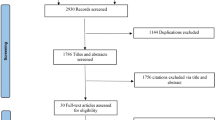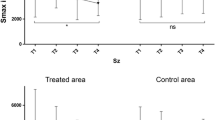Abstract
Purpose
A linear surgical scar, when located in the head and neck region, can be a significant cosmetic concern. Laser skin resurfacing with a fractional laser and a pulsed dye laser has been proven to be useful for treating such scars. As alternatives, we used a classic ablative CO2 laser in continuous mode with a 1-mm spot size and a 595-nm Nd:YAG laser. We investigated the effect of the combination of the continuous CO2 laser and 595-nm Nd:YAG laser and compared it to the effect of fractional CO2 laser monotherapy on linear scars.
Methods
This was a retrospective, case-controlled study designed to compare the efficacy between fractional CO2 laser therapy and combination therapy with a conventional CO2 laser in continuous mode and a 595-nm Nd:YAG laser. Treatment efficacy was evaluated by two different scar scales: the Stony Brook Scar Evaluation Scale (SBSES) and the modified Vancouver Scar Scale (mVSS). Laser treatments were performed every month until the 6th month after surgery.
Results
The SBSES and mVSS scores improved over time in both the monotherapy and the combination therapy (P < 0.001). No significant differences were found between the therapies for all the subcategories of the SBSES. However, among all the subcategories of the mVSS, pigmentation showed a better prognosis with combination therapy (P = 0.04).
Conclusion
Monotherapy and combination therapy can provide similar positive effects on linear scar improvement after repeated treatment, whereas combination therapy exerts more favorable anti-pigmentation effects than monotherapy. The combination of a continuous ablative CO2 laser with a 595-nm Nd:YAG laser can be used as a favorable alternative to a fractional CO2 laser. The 1-mm spot size of the CO2 laser beam may mimic the fractional laser form and offer more effective results for linear incision scars.
Level of Evidence III
This journal requires that authors assign a level of evidence to each article. For a full description of these Evidence-Based Medicine ratings, please refer to the Table of Contents or the online Instructions to Authors www.springer.com/00266.






Similar content being viewed by others
References
Capon A, Iarmarcovai G, Gonnelli D, Degardin N, Magalon G, Mordon S (2010) Scar prevention using Laser-Assisted Skin Healing (LASH) in plastic surgery. Aesthet Plast Surg 34:438–446
Gold MH, McGuire M, Mustoe TA et al (2014) Updated international clinical recommendations on scar management: part 2—algorithms for scar prevention and treatment. Dermatol Surg 40:825–831
Kim DH, Ryu HJ, Choi JE, Ahn HH, Kye YC, Seo SH (2014) A comparison of the scar prevention effect between carbon dioxide fractional laser and pulsed dye laser in surgical scars. Dermatol Surg 40:973–978
Buelens S, Van Hove AS, Ongenae K et al (2017) Fractional carbon dioxide laser of recent surgical scars in the head and neck region: a split-scar, evaluator-blinded study. Dermatol Surg 43(Suppl 1):S75–S84
Tanzi EL, Wanitphakdeedecha R, Alster TS (2008) Fraxel laser indications and long-term follow-up. Aesthet Surg J 28:675–678
Nouri K, Jimenez GP, Harrison-Balestra C, Elgart GW (2003) 585-nm pulsed dye laser in the treatment of surgical scars starting on the suture removal day. Dermatol Surg 29:65–73
Choe JH, Park YL, Kim BJ et al (2009) Prevention of thyroidectomy scar using a new 1,550-nm fractional erbium-glass laser. Dermatol Surg 35:1199–1205
Taniguchi Y, Muraoka M, Harada T, Ito N (2003) Pulsed dye laser treatment for linear scars with concave and erythematous appearance. Aesthet Plast Surg 27:205–208
Ts A, Cm W (1995) Treatment of keloid sternotomy scars with 585 nm flashlamp-pumped pulsed-dye laser. Lancet 13(345):1198–1200
Panchaprateep R, Munavalli G (2015) Low-fluence 585 nm Q-switched Nd:YAG laser: a novel laser treatment for post-acne erythema. Lasers Surg Med 47:148–155
Bowes LE, Nouri K, Berman B et al (2002) Treatment of pigmented hypertrophic scars with the 585 nm pulsed dye laser and the 532 nm frequency-doubled Nd:YAG laser in the Q-switched and variable pulse modes: a comparative study. Dermatol Surg 28:714–719
Fearmonti R, Bond J, Erdmann D, Levinson H (2010) A review of scar scales and scar measuring devices. Eplasty 21(10):e43
Manstein D, Herron GS, Sink RK, Tanner H, Anderson RR (2004) Fractional photothermolysis: a new concept for cutaneous remodeling using microscopic patterns of thermal injury. Lasers Surg Med 34:426–438
Geronemus RG (2006) Fractional photothermolysis: current and future applications. Lasers Surg Med 38:169–176
Jared Christophel J, Elm C, Endrizzi BT, Hilger PA, Zelickson B (2012) A randomized controlled trial of fractional laser therapy and dermabrasion for scar resurfacing. Dermatol Surg 38:595–602
Hedelund L, Haak CS, Togsverd-Bo K, Bogh MK, Bjerring P, Haedersdal M (2012) Fractional CO2 laser resurfacing for atrophic acne scars: a randomized controlled trial with blinded response evaluation. Lasers Surg Med 44:447–452
Majid I, Imran S (2014) Fractional CO2 laser resurfacing as monotherapy in the treatment of atrophic facial acne scars. J Cutan Aesthet Surg 7:87–92
Ts A, Ca N (1998) Pulsed dye laser treatment of hypertrophic burn scars. Plast Reconstr Surg 102:2190–2195
Khatri KA, Mahoney DL, McCartney MJ (2011) Laser scar revision: a review. J Cosmet Laser Ther 13:54–62
Liu A, Moy RL, Ozog DM (2011) Current methods employed in the prevention and minimization of surgical scars. Dermatol Surg 37:1740–1746
Chan HH, Wong DS, Ho WS, Lam L, Wei W (2004) The use of pulsed dye laser for the prevention and treatment of hypertrophic scars in Chinese persons. Dermatol Surg 30:987–994
Sobanko JF, Vachiramon V, Rattanaumpawan P, Miller CJ (2015) Early postoperative single treatment ablative fractional lasing of Mohs micrographic surgery facial scars: a split-scar, evaluator-blinded study. Lasers Surg Med 47:1–5
Jung JY, Jeong JJ, Roh HJ et al (2011) Early postoperative treatment of thyroidectomy scars using a fractional carbon dioxide laser. Dermatol Surg 37:217–223
Hong SC, Park ES, Kim YB, Nam SM (2014) Effects of minimizing scar formation by early fractional CO2 laser resurfacing. Arch Aesthet Plast Surg 20:109–113
Author information
Authors and Affiliations
Corresponding author
Ethics declarations
Conflict of interest
The authors declare that they have no conflicts of interest to disclose.
Rights and permissions
About this article
Cite this article
Lee, S.J., Lee, J.W., Kim, S.H. et al. Comparison of the Scar Prevention Effect Between a Carbon Dioxide Fractional Laser and a Continuous Ablative Carbon Dioxide Laser with a 595-nm Nd:YAG Laser. Aesth Plast Surg 43, 213–220 (2019). https://doi.org/10.1007/s00266-018-1210-2
Received:
Accepted:
Published:
Issue Date:
DOI: https://doi.org/10.1007/s00266-018-1210-2




